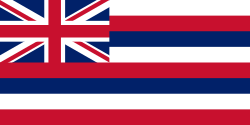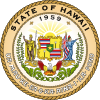
Back Hawaii ACE Hawaii Afrikaans Hawaii ALS ሃዋይኢ Amharic Hawai AMI Hawaii AN Hawaii ANG هاواي Arabic هاواي ARY هاواى ARZ
Hawaii
Hawaiʻi (Hawaiian) | |
|---|---|
| State of Hawaii Mokuʻāina o Hawaiʻi (Hawaiian) | |
| Nickname(s): | |
| Motto(s): | |
| Anthem: Hawaiʻi Ponoʻī (Hawaiʻi's Own True Sons)[4] | |
 Location of Hawaii within the United States | |
| Country | United States |
| Before statehood | Territory of Hawaii |
| Admitted to the Union | August 21, 1959 (50th) |
| Capital (and largest city) | Honolulu |
| Largest metro and urban areas | Honolulu |
| Government | |
| • Governor | Josh Green (D) |
| • Lieutenant Governor | Sylvia Luke (D) |
| Legislature | State Legislature |
| • Upper house | Senate |
| • Lower house | House of Representatives |
| Judiciary | Supreme Court of Hawaii |
| U.S. senators |
|
| U.S. House delegation | 1: Ed Case (D) 2: Jill Tokuda (D) (list) |
| Area | |
• Total | 10,931 sq mi (28,311 km2) |
| • Land | 6,423 sq mi (16,638 km2) |
| • Water | 4,507 sq mi (11,672 km2) 41.2% |
| • Rank | 43rd |
| Dimensions | |
| • Length | 1,522 mi (2,450 km) |
| • Width | n/a mi (n/a km) |
| Elevation | 3,030 ft (920 m) |
| Highest elevation | 13,796 ft (4,205.0 m) |
| Lowest elevation (Pacific Ocean[6]) | 0 ft (0 m) |
| Population (2024) | |
• Total | |
| • Rank | 40th |
| • Density | 221/sq mi (82.6/km2) |
| • Rank | 13th |
| • Median household income | $95,300 (2023)[8] |
| • Income rank | 6th |
| Demonym(s) | Hawaii resident,[9] Hawaiian[c] |
| Language | |
| • Official languages | |
| Time zone | UTC−10:00 (Hawaii) |
| USPS abbreviation | HI |
| ISO 3166 code | US-HI |
| Traditional abbreviation | H.I. |
| Latitude | 18° 55′ N to 28° 27′ N |
| Longitude | 154° 48′ W to 178° 22′ W |
| Website | hawaii |
| List of state symbols | |
|---|---|
 | |
 | |
| Living insignia | |
| Bird | Nene |
| Fish | Humuhumunukunukuāpuaʻa |
| Flower | Pua aloalo |
| Insect | Pulelehua |
| Tree | Kukui tree |
| Inanimate insignia | |
| Dance | Hula |
| Food | Kalo (taro) |
| Gemstone | ʻĒkaha kū moana (black coral) |
| Sport | Heʻe nalu (surfing) |
| State route marker | |
 | |
| State quarter | |
 Released in 2008 | |
| Lists of United States state symbols | |
Hawaii (/həˈwaɪ.i/ ⓘ hə-WY-ee;[10] Hawaiian: Hawaiʻi [həˈvɐjʔi, həˈwɐjʔi]) is an island state of the United States, in the Pacific Ocean about 2,000 miles (3,200 km) southwest of the U.S. mainland. One of the two non-contiguous U.S. states (alongside Alaska), it is the only state not on the North American mainland, the only state that is an archipelago, and the only state in the tropics.
Hawaii consists of 137 volcanic islands that comprise almost the entire Hawaiian archipelago (the exception, which is outside the state, is Midway Atoll). Spanning 1,500 miles (2,400 km), the state is physiographically and ethnologically part of the Polynesian subregion of Oceania.[11] Hawaii's ocean coastline is consequently the fourth-longest in the U.S., at about 750 miles (1,210 km).[d] The eight main islands, from northwest to southeast, are Niʻihau, Kauaʻi, Oʻahu, Molokaʻi, Lānaʻi, Kahoʻolawe, Maui, and Hawaiʻi, after which the state is named; the latter is often called the "Big Island" or "Hawaii Island" to avoid confusion with the state or archipelago. The uninhabited Northwestern Hawaiian Islands make up most of the Papahānaumokuākea Marine National Monument, the largest protected area in the U.S. and the fourth-largest in the world.
Of the 50 U.S. states, Hawaii is the fourth-smallest in land area and the 11th-least populous; but with 1.4 million residents, it ranks 13th in population density. Two-thirds of Hawaii residents live on O'ahu, home to the state's capital and largest city, Honolulu. Hawaii is one of the most demographically diverse U.S. states, owing to its central location in the Pacific and over two centuries of migration. As one of only seven majority-minority states, it has the only Asian American plurality, the largest Buddhist community,[12] and largest proportion of multiracial people in the U.S.[13] Consequently, Hawaii is a unique melting pot of North American and East Asian cultures, in addition to its indigenous Hawaiian heritage.
Settled by Polynesians sometime between 1000 and 1200 CE, Hawaii was home to numerous independent chiefdoms.[14] In 1778, British explorer James Cook was the first known non-Polynesian to arrive at the archipelago; early British influence is reflected in the state flag, which bears a Union Jack. An influx of European and American explorers, traders, and whalers soon arrived, leading to the decimation of the once-isolated indigenous community through the introduction of diseases such as syphilis, tuberculosis, smallpox, and measles; the native Hawaiian population declined from between 300,000 and one million to less than 40,000 by 1890.[15][16][17] Hawaii became a unified, internationally recognized kingdom in 1810, remaining independent until American and European businessmen overthrew the monarchy in 1893; this led to annexation by the U.S. in 1898. As a strategically valuable U.S. territory, Hawaii was attacked by Japan on December 7, 1941, which brought it global and historical significance, and contributed to America's entry into World War II. Hawaii is the most recent state to join the union, on August 21, 1959.[18] In 1993, the U.S. government formally apologized for its role in the overthrow of Hawaii's government, which had spurred the Hawaiian sovereignty movement and has led to ongoing efforts to obtain redress for the indigenous population.
Historically dominated by a plantation economy, Hawaii remains a major agricultural exporter due to its fertile soil and uniquely tropical climate in the U.S. Its economy has gradually diversified since the mid-20th century, with tourism and military defense becoming the two largest sectors. The state attracts visitors, surfers, and scientists with its diverse natural scenery, warm tropical climate, abundant public beaches, oceanic surroundings, active volcanoes, and clear skies on the Big Island. Hawaii hosts the United States Pacific Fleet, the world's largest naval command, as well as 75,000 employees of the Defense Department.[19] Hawaii's isolation results in one of the highest costs of living in the U.S. However, Hawaii is the third-wealthiest state,[19] and residents have the longest life expectancy of any U.S. state, at 80.7 years.[20]
- ^ Brodie, Carolyn S; Goodrich, Debra; Montgomery, Paula Kay (1996). The Bookmark Book. Englewood, CO: Libraries Unlimited. ISBN 9781563083006. OCLC 34164045. Retrieved August 5, 2015.
- ^ "Play Ball holds unforgettable 1st event in Hawaii". MLB.com. Archived from the original on November 19, 2019. Retrieved April 6, 2020.
- ^ Hawaii State Legislature. "Haw. Rev. Stat. § 5–9 (State motto)". Archived from the original on October 15, 2015. Retrieved December 9, 2013.
- ^ Hawaii State Legislature. "Haw. Rev. Stat. § 5–10 (State song)". Archived from the original on January 16, 2003. Retrieved December 9, 2013.
- ^ "Summit USGS 1977". NGS Data Sheet. National Geodetic Survey, National Oceanic and Atmospheric Administration, United States Department of Commerce. Retrieved October 20, 2011.
- ^ a b "Elevations and Distances in the United States". United States Geological Survey. 2001. Archived from the original on October 15, 2011. Retrieved October 21, 2011.
- ^ "United States Census Quick Facts Hawaii". Retrieved January 9, 2025.
- ^ "Household Income in States and Metropolitan Areas: 2023" (PDF). Retrieved January 12, 2025.
- ^ "Style Manual; An official guide to the form and style of Federal Government publishing" (PDF). United States Government Publishing Office. 2016. Archived (PDF) from the original on July 29, 2018. Retrieved April 27, 2020.
- ^ "Hawaii". Merriam-Webster.com Dictionary. Merriam-Webster.
- ^ "Is Hawaii a Part of Oceania or North America?". WorldAtlas. January 12, 2018. Archived from the original on July 11, 2019. Retrieved June 24, 2019.
- ^ "Religious Landscape Study". Pewforum.org. May 11, 2015. Retrieved May 27, 2018.
- ^ "Hawaii is home to the nation's largest share of multiracial Americans". Pew Research Center. June 17, 2015. Retrieved December 14, 2020.
- ^ Kirch, Patrick (2011). "When did the Polynesians Settle Hawaii? A review of 150 years of scholarly inquiry". Hawaiian Archaeology. 12: 3–26.
- ^ Office of Hawaiian Affairs (May 2017). "Native Hawaiian Population Enumerations in Hawaiʻi" (PDF). p. 22. Archived from the original (PDF) on January 26, 2022. Retrieved June 11, 2022.
- ^ Trask, Haunani-Kay (July 2016). "Lovely Hula Lands: Corporate Tourism and the Prostitution of Hawaiian Culture". Border/Lines. 23.
- ^ Trask, Haunani-Kay (1999). From a Native Daughter: Colonialism and Sovereignty in Hawaiʻi. Honolulu, HI: University of Hawaiʻi.
- ^ "[USC02] 48 USC Ch. 3: Front Matter". uscode.house.gov. Archived from the original on October 29, 2018. Retrieved October 28, 2019.
- ^ a b "Top 5 richest states in the US". www.worldfinance.com. Archived from the original on November 27, 2020. Retrieved December 15, 2020.
- ^ Arias, Elizabeth (August 23, 2022). "National Vital Statistics Reports" (PDF). CDC.gov. Retrieved February 20, 2023.
Cite error: There are <ref group=lower-alpha> tags or {{efn}} templates on this page, but the references will not show without a {{reflist|group=lower-alpha}} template or {{notelist}} template (see the help page).

